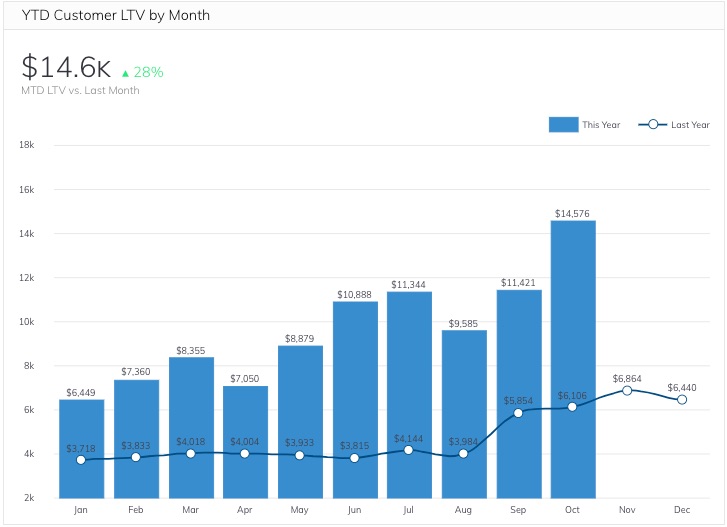How is Customer Lifetime Value calculated?
All types of businesses can benefit from understanding LTV, but there are different ways to calculate LTV depending on what kind of business you have. We’ll focus on basic methods that SaaS or other subscription-based companies can use to calculate their LTV. If you’re in ecommerce, Smile.io and Shopify both have in-depth explanations of how to calculate LTV. Other industries may calculate LTV differently, but these formulas are a good place to start.

WAYS TO CALCULATE CUSTOMER LIFETIME VALUE
Calculating LTV using an Average Revenue Per Account (ARPA or ARPU) formula is a basic way to produce an LTV for your customers and is a good starting point for LTV calculation. This is the method we used to create the metric above.
To calculate your LTV using the ARPA method, you will need to know your ARPA, Gross Margin percent, and your Customer Churn Rate. This is how the equation works:
LTV = (ARPA x Gross Margin %) / Customer Churn Rate
This basic LTV formula is a useful starting point but is only a rough estimate. It fails to properly account for MRR contraction or expansion and nonlinear churn.
Another way for SaaS or subscription-based companies to calculate LTV is to take the price of a monthly subscription and divide it by the Customer Churn Rate. If a company offers a product for $15 a month and has a churn rate of 7%, the calculation would look like this:
15/0.07 = $214.29
At a 7% churn rate, a customer’s lifetime value is $214.29 or about 14 months and is valued at $214.29. If you can optimize the types of customers you acquire and reduce churn to 6%, that same calculation yields $250 (rather than $214.29) and equates to a lifetime of almost 17 months.
If you have 1000 customers at a $15 a month price point and you’re able to increase their lifetime from 14 to 17 months, you will make an extra $35,000 on those customers.
TIP: If you offer different pricing options, you will probably have different LTVs for each price point. If this is the case at your company, you will want to calculate the LTV in each of your price segments so you can better optimize your efforts to increase the LTV of each price point.
How do I create a Customer Lifetime Value metric?
Creating an LTV metric can be a little tricky depending on the methods you use. The metric shown above was created in Grow. To create it, we pulled our ARPA data from Salesforce, which tracks our MRR. You can also pull this data from other CRMs or detailed finance software like Zuora or Quickbooks. We pulled our Gross Margin info from our accounting software, but it can also be pulled from Quickbooks Online, Xero, and other similar software. We pulled our Customer Churn Rate info from Salesforce, but it can also be pulled from other CRMs.
To see if your CRM and financial software are available to use in Grow, view our integrations here.








